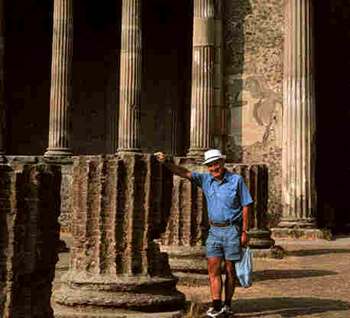|
In addition to the giant cloud of ash, Vesuvius also
erupted pyroclastic flows. Pyroclastic flows are very hot
fast-moving avalanches of ash and gas which race down the sides of
volcanoes. They move almost like hot, glowing hurricanes. Pyroclastic
flows from Vesuvius destroyed other towns near Pompeii, such as
Herculaneum and Stabiae, which were buried by up to twenty feet of ash
deposits.
After the eruption was over, the formerly bustling
landscape of the Pompeii region was gone. Green fields, streams, and
cities were replaced by a thick blanket of grey ash. The remains of
ruined buildings stuck up in places. Thousands of people were killed.
The economy of the region was ruined, and took many years to recover.
Vesuvius remained active for several hundred years. This helped cause
Pompeii and the other buried towns to be forgotten.
|

Columns that lined the large homes of Pompeii
|